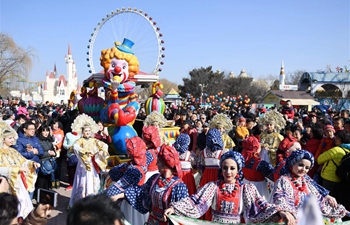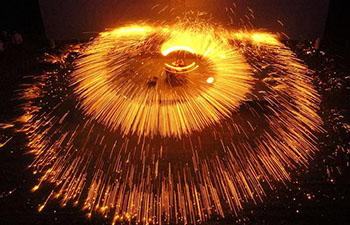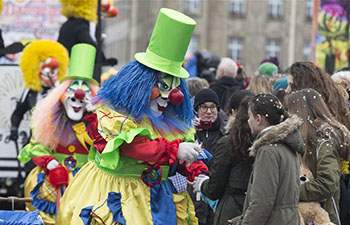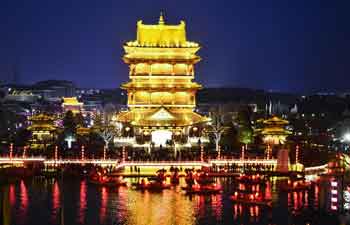HEFEI, Feb. 21 (Xinhua) -- Chen Yunqin, 43, has worked as a Shu mat weaver for nearly 30 years in Wanghe Town in east China's Anhui Province.
"My old sister taught me to weave a mat when I was 14 years old," said Chen. "Almost every woman in my village was capable of weaving a Shu mat."
A Shu mat is a traditional bamboo mat in China famous for being thin, smooth, tough, and wear-resistant. Its production can be traced back more than 2,000 years.
"It is one of the most precious folk crafts in Anhui," said Zheng Juqin, head of Qianshan County Culture Center.
Traditional Shu mats come in different types such as sleeping mats, pillow mats, tatami mats and screens, according to Tang Manjie, head of the Xinxingxin Shu Mat Cooperative, the largest producer of Shu mats in Qianshan County.
"The hand-made Shu mat is a must-have in summer for many Chinese families," Chen said.
Like Chen, a skilled worker needs to spend two days weaving an ordinary mat and four days weaving a fine mat, which costs about 1,000 yuan (about 160 U.S. dollars).
In the late 1990s, machine-made bamboo mats became popular in China as their prices were about one fourth of the prices of hand-made mats, which caused shocks in the traditional Shu mat industry.
"Almost all Shu mat producers in Wanghe were closed," Chen said. "Many mat weavers went to big cities to work and the craft was only practiced by a few people."
To preserve the craft, in 2008, Anhui Province put the Wanghe Shu Mat in the list of provincial intangible cultural heritage, to carry out systematic protection of the handiwork.
Local mat producers also went into action by improving production techniques and product quality to attract more consumers and expand markets.
Established in 2005, the Xinxingxin Shu Mat Cooperative set its eyes on the high-end mat consumption market.
"Nowadays, people pay more attention to a healthy lifestyle, and prefer to buy natural products. So the hand-made Shu mat has huge market potential," Tang said.
Xinxingxin is strict with the raw material selection for Shu mats. Tang said that to produce a high-quality Shu mat, his company only uses water bamboo, especially small leaf water bamboo that has three to four years of growing period.
Most of the water bamboo is from Hubei and Jiangxi provinces. The cutting period must be between November and February in order to prevent the bamboo from being damaged by moths, according to Tang.
"We soak the mat into a pool of tea to dye it. We do not use any chemical dyes," Tang said.
The high-end mats gained instant popularity when they hit the market. Xinxingxin produces about 25,000 Shu mats every year, accounting for half of the total output of hand-made mats in Qianshan.
Tang has set up three exclusive shops in Zhejiang, Hunan and Chongqing.
"Nowadays more and more people come to my company to learn mat weaving skills," Tang said. "I am confident that the Shu mat industry will have a bright development prospect driven by a rising market demand."

















